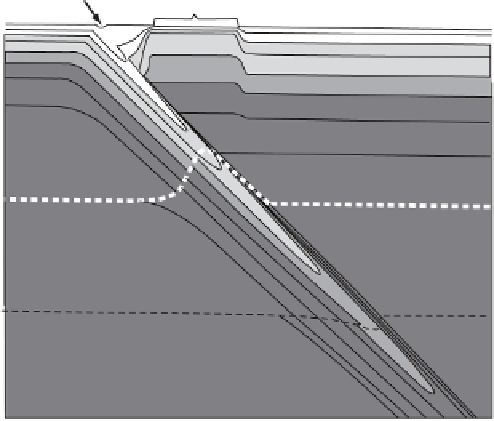Geoscience Reference
In-Depth Information
Anomalous mantle
(High heat flux)
Trench
Depth (km)
400ºC
800ºC
1,200ºC
slab
dewatering
here
continental lithosphere
oceanic
lith.
100
1000ºC
Spinel
200
300
P
Olivine
Spinel
1,600ºC
400
500
Olivine
600
Spinel
Perovskite and Magnesiowüstite
T
1,700ºC
700
800
900
Fig. 5.41
A computed estimate of subsurface temperatures achieved as a subducting slab passes down into the lower mantle. The cold slab is
denser than the ambient mantle and, despite the production of heat due to shearing along its upper interface, retains its identity to very great
depths before it merges thermally with the lower mantle. Note that the olivine to spinel phase change is elevated in the descending slab and
the dense spinel phase occurs at shallower depths here. The combination of cool, dense slab and elevated spinel transformation supplies the
negative buoyancy necessary to drive the steady slab descent as a “slab-pull” force.
in Section 5.2.7). Also, as we have previously discussed
(Section 5.1.4), volcanoes occur in volcanic arcs, not because
of frictional melting, but because massive loss of water from
dehydrating slab mantle serpentinite at
c
.150 km depth.
The topography has a thermal origin since it is due to the
buoyancy of upwelling hot asthenosphere (including some
partial melt), which underlies it (the Pratt-type isostatic
compensation discussed in Section 3.6). Top forces are
also possessed by the continental lithosphere, for the high-
est mountains lie up to 9 km above sea level. Potential
energy possessed by such elevated terrain may be liberated
as kinetic energy if the terrain in question can be decou-
pled from its rigid surroundings, that is, by basal sliding
and along peripheral strike-slip faults. The Tibetan plateau
is a case in point. Here the plateau, average elevation 5 km,
lies above a very weak lower crust (probably due to a small
degree of partial melting) and the whole area is collapsing
outward, by basal sliding rather like a crustal glacier. At the
same time it is extending by normal faulting at the surface.
Another example is the Anatolian-Aegean plate
(Fig. 2.16), which is being shoved outward due to the
energetic impact of the Arabian plate into the Iraq/Iran
part of the Asian plate along the great Zagros thrust fault.
Anatolia-Aegea is decoupling (“unzipping”) along the
North Anatolian strike-slip fault, allowing the stored
potential energy of the Anatolian Plateau, some 5 km
above the deep Hellenic trench, to be released.
Edge forces result from a number of mechanisms. The
chief one that seems to provide the major driver for plate
motions is that of
slab-pull
. This arises as a negative buoyancy
5.2.7
Why do plates move? The forces involved
Individual plates appear to be in steady, though not neces-
sarily uniform, motion. The steadiness means that acceler-
ations causing inertial effects are absent and therefore by
Newton's Second Law all relevant forces must be in bal-
ance. The occurrence of nonuniform motion is evidenced
by results from satellite GPS surveys of the continental
lithosphere (see Fig. 2.16). It means that, although rigid,
plates can strain internally by elastic deformation as part of
the cycle of stress buildup and release associated with
earthquake generation. The forces in equilibrium that
drive plate motion (Fig. 5.42) may be divided into
top
forces
that act because of differential topography,
edge forces
that act on peripheral plate boundaries, and
basal forces
that act on the bases of plates.
Top forces arise from the potential energy available to
topography. For example, the midocean ridges lie several
kilometers above the abyssal plains. A force, termed
ridge-
push
, is thus pushing the plate outward from the ridge.







Search WWH ::

Custom Search